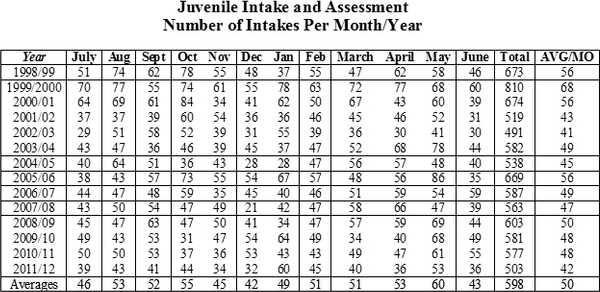For 20th Judicial District Juvenile Services Director Laurie White, the inexplicable drop in the number of young people passing through her office in the past year brings both good news and bad news. As prevention takes root, her office could lose funding.
The district’s fiscal year came to a close on June 30. From July 1, 2011, through June 30, 2012, the local Juvenile Justice Authority conducted 503 intakes, of those 174 were juvenile offenders, 150 status offenders and 179 non-offenders in the 20th’s five-county area (Barton, Ellsworth, Rice, Russell and Stafford).
Of these 503 intakes, 47, a little more than 9 percent were taken to detention and 297, or 59 percent, were returned to parent/guardian/relative/other responsible adult. The authority handles youths age birth through 18.
Statewide, according to the Kansas Juvenile Justice Authority, there were 7,291 intakes in the past year with 5.9 percent taken into custody. White and her staff are Barton County employees, but their funding comes from the KJJA.
“There are a lot of good programs in the area,” White said. “Maybe the preventative efforts are working.”
In comparing the total, the intake numbers for this year are lower that last year and the lowest in some time. “This was unlike any year since 2002/03.”
Why the totals are down presents a big question mark. “A lot of people are asking that. We’re asking that,” White said. But, no trends have been identified.
It could be the effect of the prevention programs, she said. This would seem counter intuitive since over the past two years, the Kansas Juvenile Justice Authority has cut prevention funding by 80 percent, from over $100,000 to under $20,000.
There could be another factor. Bringing a child in to JJA is up to the discretion of the responding law enforcement officer. Some are quick to do so and others opt to mediate conflicts at the scene.
“It’s subjective,” White said. “We have no control over whether they bring us a kid or don’t bring us a kid.”
There could be a cost factor as well. Prior to a change in state law July 1, all juveniles (those charged with an offence and those just needing out-of-home placement) were transported to the Bob Johnson Youth Center at Hutchinson. Now, Bob Johnson only accepts offenders, and other youth must be taken to the Wichita Children’s Home, increasing travel time and expense.
But, White’s office is funded by the Kansas Juvenile Justice Authority, a cabinet-level agency, and her budget is based on an average population formula which includes daily numbers. The figures are computed on a three-year average.
So, even though last year’s numbers were average, the low total this year will factor into the budget for the next year. “We will see a decrease in funding,” White said.
Last year’s budget was $637,327. In addition to White, the office has two full-time officers and 10-plus part-time on-call employees across the district.
This would be fine, she said, if the counts stay low. “But, if we get a bumper crop next year, we could be in trouble.”
Ultimately, the well being of the youth involved is paramount, she said. They educate officers so they have the tools to handle cases in the field.
Notices to Appear (NTAs) are another piece of the puzzle. If an officer stops a juvenile and can contact a parent in a safe environment, he will release the child into the parent’s care.
He then issues the NTA, ordering the juvenile to appear at JJA the next day. This has helped save time for all involved.
Looking at number over the past several years, there are fluctuations. “It’s a revolving cycle,” White said.
For JJA, numbers a double-edged sword





